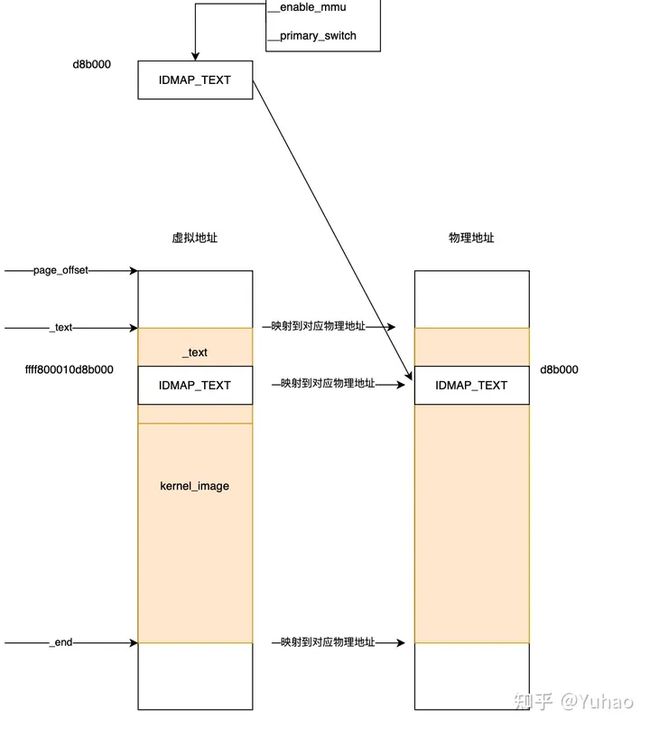Linux内存初始化-启动阶段的内存初始化
本文代码基于ARM64平台, Linux kernel 5.15
在加载kernel 之前, kernel对于系统是有一定要求的,明确规定了boot阶段必须要把MMU关闭:
arch/arm64/kernel/head.S
/*
* Kernel startup entry point.
* ---------------------------
*
* The requirements are:
* MMU = off, D-cache = off, I-cache = on or off,
* x0 = physical address to the FDT blob.那么在进入kernel之后, 就必须有一个使能MMU, 建立映射的过程, 本文描述kernel启动阶段进行内存初始化相关的操作。
流程
在初始化阶段,我们mapping二段地址,一段是identity mapping,其实就是把物理地址mapping到物理地址上去,在打开MMU的时候需要这样的mapping(ARM ARCH强烈推荐这么做的)。第二段是kernel image mapping,内核代码欢快的执行当然需要将kernel running需要的地址(kernel txt、dernel rodata、data、bss等等)进行映射了。映射之后, 系统内存的状态大致如图所示:
(图中的地址为实验机器的地址, 仅供参考)
启动入口
kernel的 启动入口是_text , 它定义在.head.text 中
arch/arm64/kernel/vmlinux.lds.S
.....
ENTRY(_text)
.....
SECTIONS
{
. = KIMAGE_VADDR;
.head.text : {
_text = .;
HEAD_TEXT
}
.....
}
arch/arm64/kernel/head.S
__HEAD
/*
* DO NOT MODIFY. Image header expected by Linux boot-loaders.
*/
efi_signature_nop // special NOP to identity as PE/COFF executable
b primary_entry // branch to kernel start, magic
.quad 0 // Image load offset from start of RAM, little-endian
le64sym _kernel_size_le // Effective size of kernel image, little-endian
.....
SYM_CODE_START(primary_entry)
bl preserve_boot_args
bl init_kernel_el // w0=cpu_boot_mode
adrp x23, __PHYS_OFFSET
and x23, x23, MIN_KIMG_ALIGN - 1 // KASLR offset, defaults to 0
bl set_cpu_boot_mode_flag
bl __create_page_tableskernel 启动后, 最终会调用到__create_page_tables这个函数, 这是创建启动页表的关键函数。
调用过程如下_text ->primary_entry->__create_page_tables
初始化准备
arch/arm64/kernel/head.S
SYM_FUNC_START_LOCAL(__create_page_tables)
mov x28, lr
/*
* Invalidate the init page tables to avoid potential dirty cache lines
* being evicted. Other page tables are allocated in rodata as part of
* the kernel image, and thus are clean to the PoC per the boot
* protocol.
*/
adrp x0, init_pg_dir
adrp x1, init_pg_end
sub x1, x1, x0
bl __inval_dcache_area
/*
* Clear the init page tables.
*/
adrp x0, init_pg_dir
adrp x1, init_pg_end
sub x1, x1, x0
1: stp xzr, xzr, [x0], #16
stp xzr, xzr, [x0], #16
stp xzr, xzr, [x0], #16
stp xzr, xzr, [x0], #16
subs x1, x1, #64
b.ne 1b__create_page_tables 初始化时, 执行的时候会把init_pg_dir 对应区域的cache清空, 然后把对应区域的内存清零。
init_pg_dir 就是启动阶段用来映射kernel text的页表, 它的本身是位于 kenrel 的bss段
arch/arm64/kernel/vmlinux.lds.S
BSS_SECTION(0, 0, 0)
. = ALIGN(PAGE_SIZE);
init_pg_dir = .;
. += INIT_DIR_SIZE;
init_pg_end = .;映射IDMAP_TEXT
identity mapping实际上就是建立了整个内核使能MMU相关代码的一致性mapping,就是将物理地址所在的虚拟地址段mapping到物理地址上去。为什么这么做呢?ARM ARM文档中有一段话:
If the PA of the software that enables or disables a particular stage of address translation differs from its VA, speculative instruction fetching can cause complications. ARM strongly recommends that the PA and VA of any software that enables or disables a stage of address translation are identical if that stage of translation controls translations that apply to the software currently being executed.
由于打开MMU操作的时候,内核代码欢快的执行,这时候有一个地址映射ON/OFF的切换过程,这种一致性映射可以保证在在打开MMU那一点附近的程序代码可以平滑切换。
下面是__create_page_tables函数中处理IDMAP的部分
arch/arm64/kernel/head.S
SYM_FUNC_START_LOCAL(__create_page_tables)
.......
/*
* Create the identity mapping.
*/
adrp x0, idmap_pg_dir
adrp x3, __idmap_text_start // __pa(__idmap_text_start)
ldr_l x4, idmap_ptrs_per_pgd
mov x5, x3 // __pa(__idmap_text_start)
adr_l x6, __idmap_text_end // __pa(__idmap_text_end)
// 根据下面的注释可以看到, x3, x6是需要映射的虚拟地址的起始和结束地址(第三个和第四个参数),这里穿的是__idmap_text_start和__idmap_text_end对应的物理地址, 同时映射的目的物理地址也传的是x3(第六个参数)
map_memory x0, x1, x3, x6, x7, x3, x4, x10, x11, x12, x13, x14
/*
* Map memory for specified virtual address range. Each level of page table needed supports
* multiple entries. If a level requires n entries the next page table level is assumed to be
* formed from n pages.
*
* tbl: location of page table
* rtbl: address to be used for first level page table entry (typically tbl + PAGE_SIZE)
* vstart: start address to map
* vend: end address to map - we map [vstart, vend]
* flags: flags to use to map last level entries
* phys: physical address corresponding to vstart - physical memory is contiguous
* pgds: the number of pgd entries
*
* Temporaries: istart, iend, tmp, count, sv - these need to be different registers
* Preserves: vstart, vend, flags
* Corrupts: tbl, rtbl, istart, iend, tmp, count, sv
*/
.macro map_memory, tbl, rtbl, vstart, vend, flags, phys, pgds, istart, iend, tmp, count, sv在map的时候, 实际上是map的idmap_text_start到idmap_text_end这一段地址。那么这段地址里面有哪些内容呢?
#define IDMAP_TEXT \
. = ALIGN(SZ_4K); \
__idmap_text_start = .; \
*(.idmap.text) \
__idmap_text_end = .;
arch/arm64/kernel/vmlinux.lds.S
...........
.text : ALIGN(SEGMENT_ALIGN) { /* Real text segment */
_stext = .; /* Text and read-only data */
IRQENTRY_TEXT
SOFTIRQENTRY_TEXT
ENTRY_TEXT
TEXT_TEXT
SCHED_TEXT
CPUIDLE_TEXT
LOCK_TEXT
KPROBES_TEXT
HYPERVISOR_TEXT
IDMAP_TEXT
HIBERNATE_TEXT
TRAMP_TEXT
*(.fixup)
*(.gnu.warning)
. = ALIGN(16);
*(.got) /* Global offset table */
}可以看到, .idmap.text 是被放在.text段中的
$ nm vmlinux | grep __idmap_text_end
ffff800010d8b760 T __idmap_text_end
$ nm vmlinux | grep __idmap_text_start
ffff800010d8b000 T __idmap_text_start
arch/arm64/kernel/head.S
.section ".idmap.text","awx"
/*
* Starting from EL2 or EL1, configure the CPU to execute at the highest
* reachable EL supported by the kernel in a chosen default state. If dropping
* from EL2 to EL1, configure EL2 before configuring EL1.
*
* Since we cannot always rely on ERET synchronizing writes to sysregs (e.g. if
* SCTLR_ELx.EOS is clear), we place an ISB prior to ERET.
*
* Returns either BOOT_CPU_MODE_EL1 or BOOT_CPU_MODE_EL2 in w0 if
* booted in EL1 or EL2 respectively.在head.S文件中, 定义了这个段, 很多内存初始化的代码都被放到了这个段里, 比如enable_mmu,primary_switch
$ nm vmlinux | grep __enable_mmu
ffff800010d8b268 T __enable_mmu
$ nm vmlinux | grep __primary_switch
ffff800010d8b330 t __primary_switch
ffff800011530330 t __primary_switched上面可以看到, 在和使能mmu相关的代码, 实际上都被放到了__idmap_text 里面, 保证切换MMU时能够平滑切换。
Idmap 实际上被映射了两次,既映射到了其kernle text的虚拟地址, 又映射到了它的物理地址。
映射kernel
创建IDMAP之后, 还会将kernel text相关的内容进行映射, 保证kernel可以正常运行
arch/arm64/kernel/head.S
SYM_FUNC_START_LOCAL(__create_page_tables)
/*
* Map the kernel image (starting with PHYS_OFFSET).
*/
adrp x0, init_pg_dir
mov_q x5, KIMAGE_VADDR // compile time __va(_text)
add x5, x5, x23 // add KASLR displacement
mov x4, PTRS_PER_PGD
adrp x6, _end // runtime __pa(_end)
adrp x3, _text // runtime __pa(_text)
sub x6, x6, x3 // _end - _text
add x6, x6, x5 // runtime __va(_end)
map_memory x0, x1, x5, x6, x7, x3, x4, x10, x11, x12, x13, x14可以看到, 这里是将_text到_end 这段物理地址映射到对应的虚拟地址上。
使能MMU
arch/arm64/kernel/head.S
SYM_FUNC_START(__enable_mmu)
mrs x2, ID_AA64MMFR0_EL1
ubfx x2, x2, #ID_AA64MMFR0_TGRAN_SHIFT, 4
cmp x2, #ID_AA64MMFR0_TGRAN_SUPPORTED
b.ne __no_granule_support
update_early_cpu_boot_status 0, x2, x3
adrp x2, idmap_pg_dir ---------------(1)
phys_to_ttbr x1, x1
phys_to_ttbr x2, x2
msr ttbr0_el1, x2 // load TTBR0 ---------------(2)
offset_ttbr1 x1, x3
msr ttbr1_el1, x1 // load TTBR1 ---------------(3)
isb
msr sctlr_el1, x0 ---------------(4)
isb
/*
* Invalidate the local I-cache so that any instructions fetched
* speculatively from the PoC are discarded, since they may have
* been dynamically patched at the PoU.
*/
ic iallu
dsb nsh
isb
ret
SYM_FUNC_END(__enable_mmu)(1)(2) 这里吧idmap_pg_dir的地址传给了ttbr0_el1;这里需要说明下, arm64 会在MMU时, 0x0000 0000 0000 0000 ~ 0xFFFF 0000 0000 0000 地址空间的内容会用ttbr0_el1 进行转换, 此时由于都是直接运行的物理地址, 所以IDMAP相关的映射全部都会走ttbr0_el1
(3) 将x1 的值赋给ttbr1_el1, 0xFFFF 0000 0000 0000 ~ 0xFFFF FFFF FFFF FFFF 空间的地址映射用用到这个寄存器, 其实就是kernel space相关的地址。在启动阶段调用__enable_mmu时, x1传的是init_pg_dir的地址。
arch/arm64/kernel/head.S
SYM_FUNC_START_LOCAL(__primary_switch)
#ifdef CONFIG_RANDOMIZE_BASE
mov x19, x0 // preserve new SCTLR_EL1 value
mrs x20, sctlr_el1 // preserve old SCTLR_EL1 value
#endif
adrp x1, init_pg_dir
bl __enable_mmu(4) 使能MMU, x0的值在调用__enable_mmu之前的__cpu_setup 函数中就设置好了
